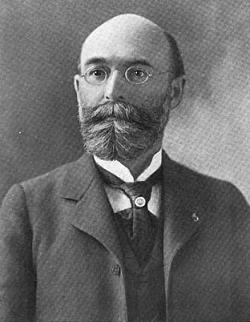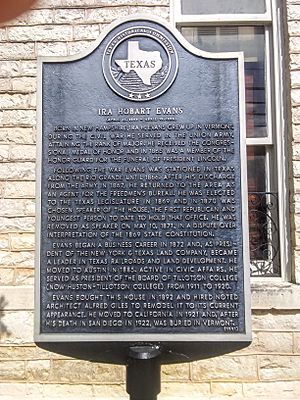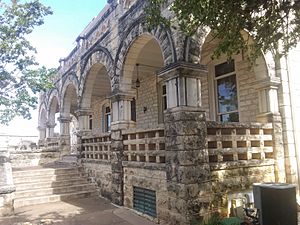Ira Hobart Evans facts for kids
Quick facts for kids
Ira Hobart Evans
|
|
|---|---|
 |
|
| Born | April 11, 1844 Piermont, New Hampshire |
| Died | April 19, 1922 (aged 78) San Diego, California |
| Place of burial |
Berlin Corners Cemetery,
Berlin, Vermont |
| Allegiance | United States of America Union |
| Service/ |
United States Army Union Army |
| Years of service | 1862–67 |
| Rank | Captain Brevet Major |
| Unit | 116th Regiment Infantry U.S. Colored Troops |
| Battles/wars | American Civil War |
| Awards | Medal of Honor |
Ira Hobart Evans (born April 11, 1844 – died April 19, 1922) was a brave officer in the Union Army during the American Civil War. He was honored with the Medal of Honor for his courage. After the war, he became a successful businessman in Texas.
Contents
Early Life of Ira Evans
Ira Evans was born in Piermont, New Hampshire, on April 11, 1844. After his father passed away, his mother moved to Barre, Vermont. Ira finished his schooling at Barre Academy.
Serving in the Civil War
In July 1862, Ira joined the Civil War as a Private. He was part of the 10th Vermont Volunteer Infantry Regiment. Later, in December 1863, he became a First Lieutenant. He served with the 9th U.S. Colored Troops.
By January 1865, he was promoted to Captain. He then served with the 116th U.S. Colored Troops. In March 1865, he was promoted again to brevet Major. This honor was for his "gallant conduct and meritorious services." He became an assistant Adjutant for the XXV Army Corps.
A Heroic Act: Medal of Honor
Captain Evans earned the Medal of Honor for his bravery. This happened in April 1865, during the Siege of Petersburg. His division was near Hatcher's Run. The area was dangerous, with enemy fire.
General William Birney needed to learn about changes in the enemy's defenses. He asked for a volunteer to question Confederate deserters. This was a very risky job. Captain Evans was the only one who stepped forward.
He rode quickly across an open field, exposed to enemy bullets. He reached the rifle pits where the deserters were. After getting the important information, he returned through more gunfire. General Birney called it a "gallant feat."
After the Civil War
On April 17, 1865, Evans was part of the honor guard. This was for President Abraham Lincoln's funeral. He stayed in the army after the war. He served in Brownsville, Texas, with General Philip Sheridan's forces. In September 1866, he moved to New Orleans. He was discharged from the army in February 1867.

Reconstruction in Texas
After the war, Ira Evans decided to help rebuild Texas. This period was called Reconstruction. He tried to start a ranch near Corpus Christi. However, he lost his money due to a dishonest partner.
He then joined the Freedmen's Bureau. This group helped formerly enslaved people. But he soon left because he disagreed with his bosses. He then worked for the Internal Revenue Service.
Texas House of Representatives
In 1869, Ira Evans ran for a political office. He was encouraged by Edmund J. Davis, a Republican candidate. Evans won a seat in the Texas House of Representatives.
In 1870, he was elected Speaker of the House. He was only 26 years old, the youngest person ever to hold that job. When Democrats regained power in 1871, Evans was removed from his position.
Business Success in Texas
Unlike many others, Evans stayed in Texas after politics. He settled in Austin and started a business career. In 1872, he became the general manager of the Texas Land Company. He also became Secretary of the Houston and Great Northern Railroad Company in 1873.
He later became Secretary of the International-Great Northern Railroad. He was also on its board of directors for many years. From 1880 to 1906, he was President of the New York and Texas Land Company. Evans helped start the Austin National Bank. He served on its board until his death. He also led the Austin Electric Railway Company for a time. He was a founder and President of the Texas Life Insurance Company.
Helping Others and Community Work
Ira Evans cared deeply about education for African-Americans. He served on the Board of Trustees for Tillotson College (now Huston–Tillotson University). He was on the board from 1881 to 1920. He was also President of the board for many years.
He donated money to build a home for the college President. He also funded a program to train construction workers. The college's Evans Industrial Building was named after him. It was built in 1912 and is now a Texas Historical Site.
Evans was active in his churches. He was involved with both the Congregational and Presbyterian churches. He served as President of the American Home Missionary Society. He was also a trustee for local churches in Austin.
He was involved in many community groups. His Austin home was a meeting place for the Texas State Historical Association. He was a member of the Society of Colonial Wars. He also joined the Military Order of the Loyal Legion of the United States. In 1896, he helped start the Texas Society of the Sons of the American Revolution.
His Austin home, the North-Evans Chateau, is now the Austin Woman's Club. It is an Austin Historic Landmark.
Personal Life
Ira Evans was married twice. In July 1871, he married Frances A. Hurlbut. They had three sons: William, Francis, and Hobart. After their divorce in 1917, he married Jessie M. Stewart in 1920. He was also a cousin of the Texas businessman Timothy Dwight Hobart.
His personal papers are kept at the University of Tulsa's McFarlin Library.
Later Years and Passing
Ira Evans retired to San Diego, California, in 1921. He passed away there on April 19, 1922. He was buried in Berlin Corners Cemetery, Berlin, Vermont.


